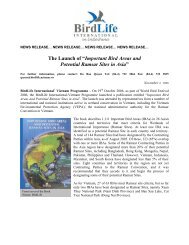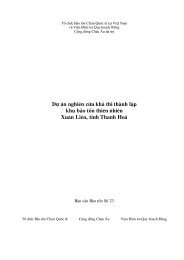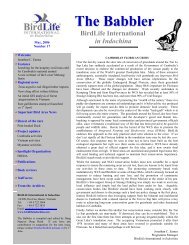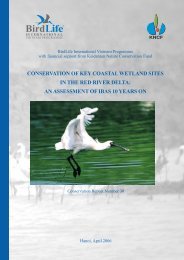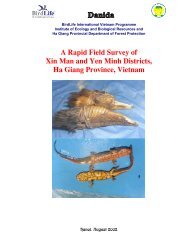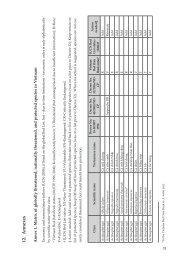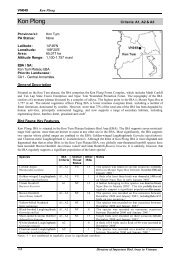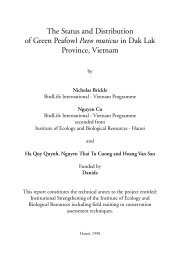A Feasibility Study for the Establishment of Xuan Lien Nature ...
A Feasibility Study for the Establishment of Xuan Lien Nature ...
A Feasibility Study for the Establishment of Xuan Lien Nature ...
Create successful ePaper yourself
Turn your PDF publications into a flip-book with our unique Google optimized e-Paper software.
Section 1 - Introduction<br />
2<br />
(b) Watershed Protection Forests. These <strong>for</strong>ested areas can be allocated to <strong>for</strong>estry agencies,<br />
people’s committees, or to <strong>the</strong> people directly, with <strong>the</strong> main purposes <strong>of</strong> watershed<br />
protection, soil erosion control and <strong>for</strong>eshore protection with special provisions as per<br />
Articles 35-37; and<br />
(c) Special-use Forests. These are <strong>for</strong>ested lands allocated <strong>for</strong> environment conservation, tourism,<br />
educational purposes, national defence, and o<strong>the</strong>r special uses. These lands can be allocated<br />
to organisations and agencies in <strong>the</strong> state <strong>for</strong>estry sector which are expected to generate<br />
revenues outside <strong>of</strong> <strong>the</strong> strict preservation areas and follow management procedures as per<br />
Articles 39-41. Special-use Forests are fur<strong>the</strong>r subdivided into:<br />
(i) Cultural and Historical Sites to preserve and maintain areas <strong>of</strong> national and cultural<br />
interest and importance;<br />
(ii) <strong>Nature</strong> Reserves intended to preserve all representative <strong>for</strong>est types and to conserve<br />
biodiversity; and<br />
(iii) National Parks to protect and conserve all major types <strong>of</strong> wildlife and habitat types<br />
found within <strong>of</strong> Vietnam.<br />
Vietnam currently has proposals <strong>for</strong> 105 protected areas, comprising 976,000 ha or 3% <strong>of</strong> <strong>the</strong> total<br />
land area. Under Special-use Forest classification <strong>the</strong>re are 10 national parks, 61 nature reserves, and 34<br />
cultural <strong>of</strong> historical sites (Dang Huy Huynh 1998). Vietnam is actively gazetting new sites as part <strong>of</strong> its<br />
treaty obligations under <strong>the</strong> Convention on Biological Diversity. Under this treaty, Vietnam has agreed<br />
to increase its protected area system to 2,000,000 ha by <strong>the</strong> year 2000, <strong>the</strong>reby doubling its network <strong>of</strong><br />
Special-use Forests.<br />
Vietnam supports approximately 275 mammal species, 826 bird species, 260 reptile species, 82 amphibian<br />
species, 500 freshwater fish species, 2,000 marine fish species and 12,000 plant species (Dang Huy<br />
Huynh 1998, MacKinnon 1996).<br />
1.3 Forest in Thanh Hoa Province<br />
The natural vegetation <strong>of</strong> Thanh Hoa province is semi-evergreen rain<strong>for</strong>est in <strong>the</strong> lowlands in <strong>the</strong> east<br />
and centre <strong>of</strong> <strong>the</strong> province, with sub-montane dry evergreen <strong>for</strong>est in <strong>the</strong> mountains in <strong>the</strong> west<br />
(MacKinnon 1996). A thin belt <strong>of</strong> limestone <strong>for</strong>est runs across <strong>the</strong> north <strong>of</strong> <strong>the</strong> province, along <strong>the</strong><br />
borders with Ninh Binh and Hoa Binh provinces.<br />
In Thanh Hoa province, <strong>for</strong>est cover originally stretched from <strong>the</strong> coastal plains to <strong>the</strong> border with<br />
Laos. However, <strong>the</strong> coastal plains were almost entirely de<strong>for</strong>ested prior to 1945 to make way <strong>for</strong> wet rice<br />
cultivation. Since <strong>the</strong>n, <strong>the</strong>re has been a gradual erosion <strong>of</strong> <strong>for</strong>est in <strong>the</strong> foothills and mountains in <strong>the</strong><br />
centre and west <strong>of</strong> <strong>the</strong> province, as a result <strong>of</strong> shifting cultivation, commercial logging activities and<br />
resettlement <strong>of</strong> people from <strong>the</strong> lowlands. Between 1983 and 1995, 95,000 ha <strong>of</strong> <strong>for</strong>est was lost, at a<br />
rate <strong>of</strong> 8,000 ha per year (unpublished data from <strong>the</strong> Forest Inventory and Planning Institute (FIPI)).<br />
In <strong>the</strong> foothills, remaining <strong>for</strong>est areas are fragmented. However, large areas <strong>of</strong> continuous <strong>for</strong>est cover<br />
remain in <strong>the</strong> mountains close to <strong>the</strong> border with Laos.<br />
The current and proposed system <strong>of</strong> Special-use Forests in Thanh Hoa province includes Ben En National<br />
Park, in <strong>the</strong> south-east <strong>of</strong> <strong>the</strong> province, which covers 16,634 ha. Three proposed nature reserves in <strong>the</strong><br />
west <strong>of</strong> <strong>the</strong> province, Pu Luong, Pu Hu and <strong>Xuan</strong> <strong>Lien</strong>, cover a fur<strong>the</strong>r 56,857 ha. Additionally, limestone






